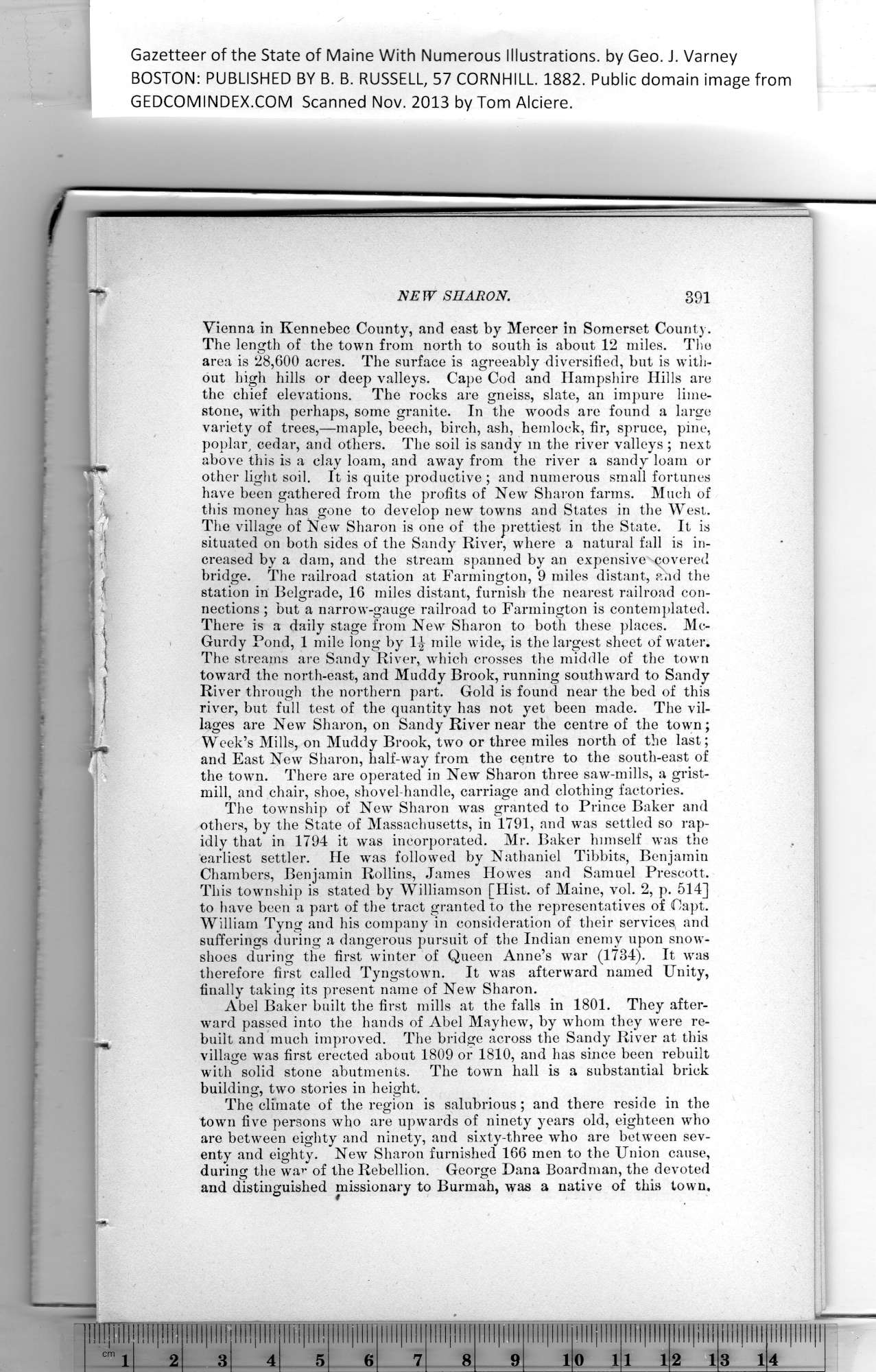|
Gazetteer of the State of Maine With Numerous Illustrations, by Geo. J. Varney
BOSTON: PUBLISHED BY B. B. RUSSELL, 57 CORNHILL. 1882. Public domain image from
Vienna in Kennebec County, and east by Mercer in Somerset County.
The length of the town from north to south is about 12 miles. The
area is 28,600 acres. The surface is agreeably diversified, but is with-
out high hills or deep valleys. Cape Cod and Hampshire Hills are
the chief elevations. The rocks are gneiss, slate, an impure lime-
stone, with perhaps, some granite. In the woods are found a large
variety of trees,—maple, beech, birch, ash, hemlock, fir, spruce, pine,
poplar, cedar, and others. The soil is sandy m the river valleys ; next
above this is a clay loam, and away from the river a sandy loam or
other light soil. It is quite productive ; and numerous small fortunes
have been gathered from the profits of New Sharon farms. Much of
this money has gone to develop new towns and States in the West.
The village of New Sharon is one of the prettiest in the State. It is
situated on both sides of the Sandy River, where a natural fall is in-
creased by a dam, and the stream spanned by an expensive -qovered
bridge. The railroad station at Farmington, 9 miles distant, and the
station in Belgrade, 16 miles distant, furnish the nearest railroad con-
nections ; but a narrow-gauge railroad to Farmington is contemplated.
There is a daily stage from New Sharon to both these places. Me-
Gurdy Pond, 1 mile long by 1^ mile wide, is the largest sheet of water.
The streams are Sandy River, which crosses the middle of the town
toward the north-east, and Muddy Brook, running southward to Sandy
River through the northern part. Gold is found near the bed of this
river, but full test of the quantity has not yet been made. The vil-
lages are New Sharon, on Sandy River near the centre of the town;
Week’s Mills, on Muddy Brook, two or three miles north of the last;
and East New Sharon, half-way from the centre to the south-east of
the town. There are operated in New Sharon three saw-mills, a grist-
mill, and chair, shoe, shovel-handle, carriage and clothing factories.
The township of New Sharon was granted to Prince Baker and
others, by the State of Massachusetts, in 1791, and was settled so rap-
idly that in 1794 it was incorporated. Mr. Baker himself was the
earliest settler. He was followed by Nathaniel Tibbits, Benjamin
Chambers, Benjamin Rollins, James Howes and Samuel Prescott.
This township is stated by Williamson [Hist, of Maine, vol. 2, p. 514]
to have been a part of the tract granted to the representatives of Capt.
William Tyng and his company in consideration of their services and
sufferings during a dangerous pursuit of the Indian enemy upon snow-
shoes during the first winter of Queen Anne’s war (1734). It was
therefore first called Tyngstown. It was afterward named Unity,
finally taking its present name of New Sharon.
Abel Baker built the first mills at the falls in 1801. They after-
ward passed into the hands of Abel Mayhew, by whom they were re-
built and much improved. The bridge across the Sandy River at this
village was first erected about 1809 or 1810, and has since been rebuilt
with solid stone abutments. The town hall is a substantial brick
building, two stories in height.
The climate of the region is salubrious; and there reside in the
town five persons who are upwards of ninety years old, eighteen who
are between eighty and ninety, and sixty-three who are between sev-
enty and eighty. New Sharon furnished 166 men to the Union cause,
during the war of the Rebellion. George Dana Boardman, the devoted
and distinguished missionary to Burmah, was a native of this town.
PREVIOUS PAGE ... NEXT PAGE
This page was written in HTML using a program written in Python 3.2
|
